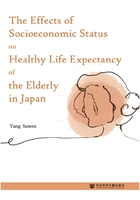
1.4 Study Objectives,Originality and Significance
1.4.1 A Comprehensive View of Previous Studies
Findings from previous studies enhanced our understanding of the effect of SES on HALE,and provided recommendations for improving HALE among elderly people. Although there is a well-established relationship between SES and HALE according to which people with higher SES live longer in good health compared to people with lower SES,inconsistent results were reported in previous studies due to different research designs and cultures. In addition,although several recent studies examined SES and HALE among the Japanese,all of them focused on special populations such as the elderly living alone,elderly with impairment,or patients with certain diseases. To date,few studies have investigated the association between SES and HALE among elderly people in large-scale follow-up studies in Japan. Specifically,previous research has had critical limitations in the attempts to understand how the SES affects HALE of individual elderly people in Japan,as follows.
(1)Past research has calculated HALE using various methods that account for both mortality and morbidity in a single index within a representative sample;however,few detailed studies objectively and systematically assessed the HALE as living longer and healthier at the individual level,particularly for elderly people.
(2)Previous studies considered physical functioning,illness,LTC need,and SRH as HALE measures;however,the structural causal relationship among them was overlooked. In addition,in previous studies that evaluated the relationships between individual physical health status and SRH,or mortality,they limited their assessments to combine all the variables to explore their underlying relationships.
(3)A large number of previous studies explored the relationship between SES and HALE,and showed direct and indirect effects by survival analysis or logistic regression. Few studies adequately incorporated multiple factors or the relationships among these factors,which have been found to be significantly related to HALE of the elderly by using the SEM to analyze and show the inter-relationships.
(4)A few of the previous studies explored the SES effect on HALE by controlling certain demographic variables,such as age and gender. However,less attention has been given to the theoretically and practically relevant question of whether SES and HALE associations differ in population subgroups,such as those that differ by gender,age,and location.
1.4.2 Study Objectives
The purpose of this empirical study is to examine the structural relationships among SES,physical health,LTC level,and HALE of the Japanese elderly. More precisely,this book aims to explore the SES-HALE mechanism of Japanese elderly individuals. It is premised that SES is directly or indirectly related to the HALE of Japanese elderly depending on gender,age,and geographic location. The following three objectives are established:
(1)Describe the characteristics of SES,HALE,LTC,and physical health status among Japanese elderly people;
(2)Assess the direct and indirect effects of SES on physical health,LTC,and HALE of Japanese elderly people;
(3)Explore the SES-HALE mechanism differences by gender,age,and geographic location of Japanese elderly people.
1.4.3 Study Originality and Significance
Due to a paucity of empirical studies on HALE of elderly people,there is a knowledge gap in the understanding of whether or not elderly people live longer in good health. Japan ranks as having the highest HALE in the world;thus,this study may be able to bridge the gap by clarifying the measurement of HALE and estimating a series of best-fit models of Japanese elderly people.
Furthermore,for many years,diverse conceptual and theoretical models have been proposed to explore the social determinants of health status of older individuals. Based on large-scale surveys and the advanced statistical software(e.g. SPSS and SEM for Windows),the empirical study represents an effort to investigate the mechanism by which SES takes multiple pathways to exert direct and indirect effects on the HALE among Japanese elderly people,considering the differences by population subgroups,including gender,age,and geographic location.
This book used data from 1995-2007 at both prefectural and individual levels;during this period,Japan transitioned from an aged society to a super-aged society. This study can provide valuable information on how SES affects HALE of Japanese elderly people,which could help social workers develop planning interventions and deliver effective services to improve elderly people’s QOL by considering their individual differences and needs. Furthermore,implications for reducing the LTC/support cost in the future can be elicited.